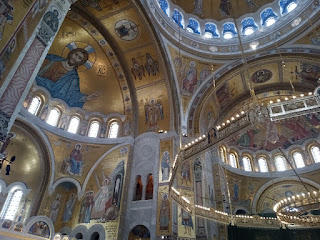The Barber of Belgrade
I hadn’t gotten a haircut for almost three months. I was two weeks overdue. I had had a pretty regular schedule of a haircut every two and a half months since the start of 2018. Unlike every barber I had seen, almost ever, this time I had had to make a booking for my haircut. In the early morning drizzle I found a barbershop and made a booking for their next available slot at three fifteen in the afternoon. I spent the day killing time and now I was running late for my appointment.
When I arrived in Belgrade three days earlier large letters graffitied in English over a pedestrian bridge declared that “Kosovo is Serbia.” Tensions and fighting in northern Kosovo had been in the news again and I was expecting that tension to be palpable by the time I got to the Serbian capital. Ultimately though the tension had been sustained in the region since the Albanian majority declared Kosovo independent in 2008, highlighting an already strong tension that existed for a while before that. So the news of a flare up in Kosovo was not particularly jarring to anyone in Belgrade.But it was a sign of the ongoing disagreements that have plagued the Balkans since the time of the Romans. The Balkans are prime real estate. They sit between east and west which means the region is a melting pot for cultural diversity. It also means that the region is constantly tense and fraught with disagreement about who owns what. Whilst not at war at the moment, the flames of the last war in Bosnia-Herzegovina continue to smoulder, waiting for the next disagreement to grow into something more.
Needless to say Belgrade, a place that has been key in making decisions that have manifested wars, does not feel tense day-to-day. No one is ever trying to take Belgrade away from the Serbs. The city feels relatively European. The centre has a mix of neoclassical and communist architecture. The white Saint Sava Temple stands tall and large, the centre of the Serbian Orthodox community. In amongst the grey and beige buildings there are signs of NATO bombings in the late nineties. A few buildings cut in half by the bombings are scattered around the city, left in the state they were the day they were shelled, a reminder of what had happened.
For most Slavic countries in Europe, the most obvious legacy left of former unity is the similarities between their flags. Whilst this was a subtle reminder of the past in places like Croatia, Slovenia and Slovakia, the red, blue and white stripes on the Serbian flag felt much more prominent. Around Belgrade red and blue Soviet-era trams click-clacked down the street filled to the brim with commuters. Though I only passed through Novi Sad, its bus station was likewise filled with scruffy, blue and white, decades-old buses that looked the same way they did the day democracy arrived in the nineties.
Back on my drizzly morning in Belgrade, I was trying to fill time until my haircut in the afternoon. I headed to a place I’d become very familiar with in Croatia - the ‘pekara’ or bakery. In the centre of Zagreb there was a bakery, and sometimes more than one, on every block - and the same was true in the heart of Belgrade. The venues were always filled with bread, pastries and customers. Like in Croatia, burek was eaten with a cup of thin, drinkable yogurt on the side. But not just with burek. If you were going into a bakery you were having yogurt to drink. A sandwich with yogurt, a pastry with yogurt, a slice of pizza with yogurt.
After lunch I explored the fortress overlooking the Danube and spent some time by the river. I had followed the river, at least indirectly, through Vienna, Bratislava and Budapest. Belgrade was the last major city I’d be visiting in which the river passed through. I relaxed by the river, probably for too long because before I knew it I was running late to my haircut appointment. I rushed through the city centre, unsure of why I had chosen a barbershop so far away. I eventually got to the barbershop only five minutes late and was seated immediately.
As a global society we have had difficulty in standardising and universalising units of measure. Distance can be measured in kilometres or miles. An American measures the temperature in Fahrenheit while a Swede measures it in Celsius. Your shoe size will be a different number if you are in a different part of the world or a different gender. Electrical plugs vary based on the continent you’re in and which empire ruled last. But for some reason, no matter where I am in the world and no matter what language my barber speaks, they all have exactly the same size clippers. I can give the same haircut request to a barber in central Thailand as I can to a barber in Sydney without any issue. And this is what I did in Belgrade.
The barber wrapped a piece of paper around my neck, a bit too tightly, as I looked around the shop. I was on the other side of the world in the capital of what was Yugoslavia and yet I was in the fanciest barbershop I’d ever been in. Vinyl records covered the wall behind an espresso machine and a filtered water tap. Men were sitting around chatting over the loud rap music booming from the nearby stereo. It was the type of place where people came, not to get a haircut, but maybe a ‘trim’ or a ‘style cut.’ As someone with no style I was unsure of what the latter actually was. Worst of all, unlike any place I’ve received a haircut in the last twenty years, and in cash-heavy Serbia, they accepted credit cards. I sat bewildered as the clippers made their way towards my head.
















